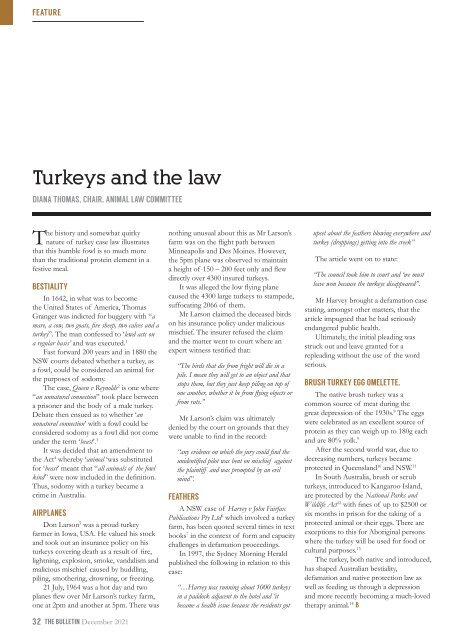LSB December 2021 HR
Create successful ePaper yourself
Turn your PDF publications into a flip-book with our unique Google optimized e-Paper software.
FEATURE<br />
Turkeys and the law<br />
DIANA THOMAS, CHAIR, ANIMAL LAW COMMITTEE<br />
The history and somewhat quirky<br />
nature of turkey case law illustrates<br />
that this humble fowl is so much more<br />
than the traditional protein element in a<br />
festive meal.<br />
BESTIALITY<br />
In 1642, in what was to become<br />
the United States of America, Thomas<br />
Granger was indicted for buggery with “a<br />
mare, a cow, two goats, five sheep, two calves and a<br />
turkey”. The man confessed to ‘lewd acts on<br />
a regular basis’ and was executed. 1<br />
Fast forward 200 years and in 1880 the<br />
NSW courts debated whether a turkey, as<br />
a fowl, could be considered an animal for<br />
the purposes of sodomy.<br />
The case, Queen v Reynolds 2 is one where<br />
“an unnatural connection” took place between<br />
a prisoner and the body of a male turkey.<br />
Debate then ensued as to whether ‘an<br />
unnatural connection’ with a fowl could be<br />
considered sodomy as a fowl did not come<br />
under the term ‘beast’. 3<br />
It was decided that an amendment to<br />
the Act 4 whereby ‘animal ‘was substituted<br />
for ‘beast’ meant that “all animals of the fowl<br />
kind” were now included in the definition.<br />
Thus, sodomy with a turkey became a<br />
crime in Australia.<br />
AIRPLANES<br />
Don Larson 5 was a proud turkey<br />
farmer in Iowa, USA. He valued his stock<br />
and took out an insurance policy on his<br />
turkeys covering death as a result of fire,<br />
lightning, explosion, smoke, vandalism and<br />
malicious mischief caused by huddling,<br />
piling, smothering, drowning, or freezing.<br />
21 July, 1964 was a hot day and two<br />
planes flew over Mr Larson’s turkey farm,<br />
one at 2pm and another at 5pm. There was<br />
32 THE BULLETIN <strong>December</strong> <strong>2021</strong><br />
nothing unusual about this as Mr Larson’s<br />
farm was on the flight path between<br />
Minneapolis and Des Moines. However,<br />
the 5pm plane was observed to maintain<br />
a height of 150 – 200 feet only and flew<br />
directly over 4300 insured turkeys.<br />
It was alleged the low flying plane<br />
caused the 4300 large turkeys to stampede,<br />
suffocating 2066 of them.<br />
Mr Larson claimed the deceased birds<br />
on his insurance policy under malicious<br />
mischief. The insurer refused the claim<br />
and the matter went to court where an<br />
expert witness testified that:<br />
“The birds that die from fright will die in a<br />
pile. I mean they will get to an object and that<br />
stops them, but they just keep piling on top of<br />
one another, whether it be from flying objects or<br />
from rats.”<br />
Mr Larson’s claim was ultimately<br />
denied by the court on grounds that they<br />
were unable to find in the record:<br />
“any evidence on which the jury could find the<br />
unidentified pilot was bent on mischief against<br />
the plaintiff and was prompted by an evil<br />
mind”.<br />
FEATHERS<br />
A NSW case of Harvey v John Fairfax<br />
Publications Pty Ltd 6 which involved a turkey<br />
farm, has been quoted several times in text<br />
books 7 in the context of form and capacity<br />
challenges in defamation proceedings.<br />
In 1997, the Sydney Morning Herald<br />
published the following in relation to this<br />
case:<br />
“…Harvey was running about 1000 turkeys<br />
in a paddock adjacent to the hotel and ‘it<br />
became a health issue because the residents got<br />
upset about the feathers blowing everywhere and<br />
turkey (droppings) getting into the creek”<br />
The article went on to state:<br />
“The council took him to court and ‘we must<br />
have won because the turkeys disappeared”.<br />
Mr Harvey brought a defamation case<br />
stating, amongst other matters, that the<br />
article impugned that he had seriously<br />
endangered public health.<br />
Ultimately, the initial pleading was<br />
struck out and leave granted for a<br />
repleading without the use of the word<br />
serious.<br />
BRUSH TURKEY EGG OMELETTE.<br />
The native brush turkey was a<br />
common source of meat during the<br />
great depression of the 1930s. 8 The eggs<br />
were celebrated as an excellent source of<br />
protein as they can weigh up to 180g each<br />
and are 80% yolk. 9<br />
After the second world war, due to<br />
decreasing numbers, turkeys became<br />
protected in Queensland 10 and NSW. 11<br />
In South Australia, brush or scrub<br />
turkeys, introduced to Kangaroo Island,<br />
are protected by the National Parks and<br />
Wildlife Act 12 with fines of up to $2500 or<br />
six months in prison for the taking of a<br />
protected animal or their eggs. There are<br />
exceptions to this for Aboriginal persons<br />
where the turkey will be used for food or<br />
cultural purposes. 13<br />
The turkey, both native and introduced,<br />
has shaped Australian bestiality,<br />
defamation and native protection law as<br />
well as feeding us through a depression<br />
and more recently becoming a much-loved<br />
therapy animal. 14 B


















